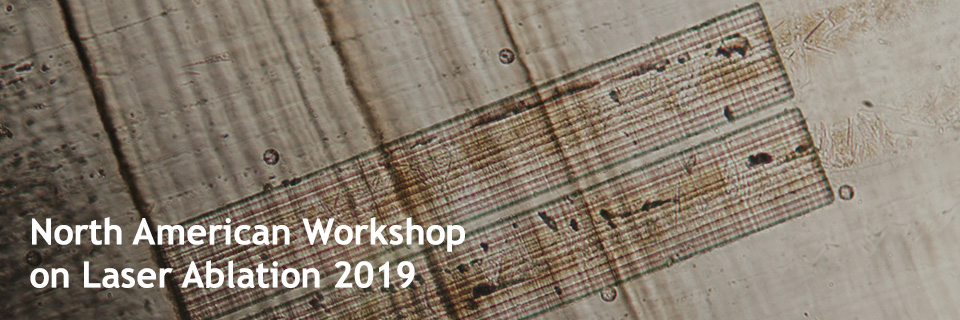The North American Workshop on Laser Ablation (NAWLA) was hosted by the Jackson School of Geosciences, University of Texas at Austin, May 28, 29-31, 2019
NAWLA19 Abstract Volume
NAWLA is a biennial meeting held in odd years with the mission to facilitate laser ablation knowledge transfer and promote community among North American laser ablation users. The workshop format includes invited plenary oral presentations, contributed oral and poster presentations, moderated discussions, and group workshop activities. Plenary presentations review the state-of-the-art on particular topics, identify key issues in the topic that might yield the most useful research results for the future, and provide a framework for discussions at the workshop. Workshop activities are intended to facilitate knowledge transfer among diverse users with a variety of analytical experience. Topical areas covered in the workshop include:
FOUNDATIONS & FUNDAMENTALS
|
INSTRUMENTATION
|
APPLICATIONS
|
Deadlines
Registration (includes coffee, lunch, and gala dinners)
- $150 Early Registration (by 23:59 CT, April 30)
- $200 Regular Registration (after April 30)
- $45 Pre-meeting Workshop 1 (LA-ICPMS: Principles and Applications)
- $25 Pre-meeting Workshop 2 (An Introduction to LA-ICP-MS Data Processing with iolite 4)
- Register Now
Abstracts
- Submissions for oral and poster presentation should be made by 23:59 CT, April 30
- Abstracts received after May 15 cannot be guaranteed for inclusion in the abstract volume
- As there are limited slots for talks, some submissions will be allocated to poster presentations.
- Submit an Abstract
Pre-meeting Workshops (Tue, May 28)
Workshop 1: LA-ICPMS: Principles and Applications – Leonid Danyushevsky (U. Tasmania)
Workshop 2: An Introduction to LA-ICP-MS Data Processing with iolite 4 – Bence Paul, Joe Petrus
Workshops include coffee and lunch.
It’s back! NAWLA 2019 Laser Ablation Image Contest
 NAWLA and iolite software are pleased to announce the 2nd Laser Ablation Image Contest as part of NAWLA 2019. You are invited to submit images that you have created using laser ablation for your chance to win a $1000 cash prize, as selected by the popular vote! To enter, just make sure you’ve registered for NAWLA 2019, then send your entry to nawlaimagecontest@iolite-software.com.
NAWLA and iolite software are pleased to announce the 2nd Laser Ablation Image Contest as part of NAWLA 2019. You are invited to submit images that you have created using laser ablation for your chance to win a $1000 cash prize, as selected by the popular vote! To enter, just make sure you’ve registered for NAWLA 2019, then send your entry to nawlaimagecontest@iolite-software.com.
Plenary Session and Q&A Panel Discussion on LA-ICP-MS Data Reduction Software
Prof. Yongsheng Liu (China University of Geosciences, Wuhan): ICPMSDataCal is written in Visual Basic programming language, runs in Microsoft Excel, and is used widely in China.
Dr. Regina Mertz-Kraus (Johannes Gutenberg-Universität Mainz, Germany): TERMITE is written in the statistical language R, which is open-source software freely available from CRAN and provides several powerful statistical and graphical features.
Dr. Ashley Norris (Norris Scientific, Tasmania, Australia): LADR (Laser Ablation Data Reduction Software), pronounced “ladder”. Runs on Microsoft Windows 7, 8, and 10, both 32 and 64 bit versions, and requires .NET version 4.6.1.
Dr. Bence Paul (The University of Melbourne, Australia): Iolite is a popular software that runs as a series of Igor Pro procedures. The new Iolite 4 release is a complete re-write in C++ that runs natively on Mac and Windows operating systems.
Dr. Stijn J. M. Van Malderen (DESY-HASYLAB, Hamburg, Germany): HDIP (HDF-based Image Processing) is a software platform designed to process imaging data stored in the HDF5 format. HDF5 is a highly versatile format for storing large volumes of data.
Workshop Activity: Reference Materials for LA-ICP-MS
Alan Koenig and Kate Souders (USGS Denver)
Confirmed Speakers
Jan Fietzke (GEOMAR Helmholtz Centre Kiel, Germany) – “Influence of plasma conditions on elemental behavior during LA-ICP-MS”
Dieter Garbe-Schönberg (CAU Kiel University, Germany) – “Nano-particulate pressed powder pellets (not only) for LA-ICP-MS”
Malte Willmes (U California Davis) – “Rocks, Bones, and Teeth: New frontiers and old problems in strontium isotope analysis in ecology and archaeology”
Wei Chen (China University of Geosciences, Wuhan) – “In-situ sulfur isotope measurements by LA-MC-ICP-MS: sulfate standards and matrix effects”
Tao Luo (China University of Geosciences, Wuhan) – “Water vapor-assisted ‘universal’ nonmatrix-matched analytical method for U–Pb dating”
Hehe Jiang (Rice University – Houston TX) – “Reconstructing paleo-hydrologic history with LA-ICPMS U-Pb dating and trace element analyses on agates”.
Todor Todorov (U.S. Food and Drug Administration, College Park, MD) – “Evaluating the accumulation of toxic and nutrient elements in rice grains using 3D bioimaging by means of laser ablation ICP-MS”
Staci Loewy (U Texas Austin) – “Performance of a Multiple-Daly Detector System for Isotopic Analyses by MC-ICP-MS”
Tobias Fusswinkel (RWTH Aachen University, Germany) – “LA-ICP-MS microanalysis of fluid inclusions”
Mark Golitko (U Notre Dame) – “Laser Ablation-ICP-MS in Archaeology”
Amy Managh (Loughborough University, UK) – “High Resolution Imaging of Explant Tissue in Anti-Cancer Therapy”
Dany Savard (Universite du Quebec a Chicoutimi) – “Overview and preliminary results of the promising fs-LA-LIBS-ICP-TOF-MS system”
Thomas Zack (U Gothenburg, Sweden) – “Recent findings of in-situ beta-decay geochronology: Rb-Sr dating of glauconite and Re-Os dating of molybdenite”
Matt Horstwood (British Geological Survey) – “Uncertainties and resolution of variation in LA-ICP-MS”
Leonid Danyushevsky (University of Tasmania) – “Accurate LA-ICP-MS analysis of minerals using non-matrix matched reference materials”
Nancy McMillan (New Mexico State University) – “Geological applications of handheld and benchtop Laser‐Induced Breakdown Spectroscopy”



